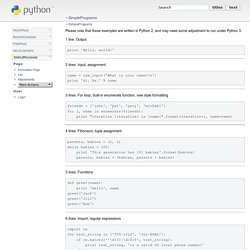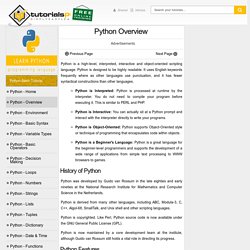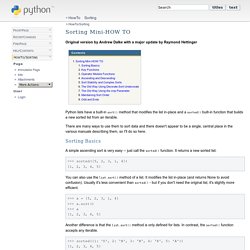

Perl Tutorial. Perl is a programming language developed by Larry Wall, especially designed for text processing.

Though Perl is not officially an acronym but many times it is used as it stands for Practical Extraction and Report Language. It runs on a variety of platforms, such as Windows, Mac OS, and the various versions of UNIX. This tutorial provides a complete understanding on Perl. This reference has been prepared for beginners to help them understand the basic to advanced concepts related to Perl Scripting languages.
Before you start practicing with various types of examples given in this reference, we are making an assumption that you have prior exposure to C programming and Unix Shell. For most of the examples given in this tutorial you will find Try it option, so just make use of this option to execute your Perl programs at the spot and enjoy your learning. Try following example using Try it option available at the top right corner of the below sample code box − Practice Python. Python Functions. A function is a block of organized, reusable code that is used to perform a single, related action.

Functions provide better modularity for your application and a high degree of code reusing. As you already know, Python gives you many built-in functions like print(), etc. but you can also create your own functions. These functions are called user-defined functions. Defining a Function You can define functions to provide the required functionality. Function blocks begin with the keyword def followed by the function name and parentheses ( ( ) ).Any input parameters or arguments should be placed within these parentheses.
Syntax def functionname( parameters ): "function_docstring" function_suite return [expression] By default, parameters have a positional behavior and you need to inform them in the same order that they were defined. Example The following function takes a string as input parameter and prints it on standard screen. Calling a Function #! I'm first call to user defined function! #! #! #! Python Basic Syntax. The Python language has many similarities to Perl, C, and Java.

However, there are some definite differences between the languages. First Python Program Let us execute programs in different modes of programming. Interactive Mode Programming Invoking the interpreter without passing a script file as a parameter brings up the following prompt: PythonBooks - Learn Python the easy way ! Welcome - Learn Python - Free Interactive Python Tutorial. Looping the loop. In the last exercise we printed out part of the 12 times table.

But it took a lot of typing and if we needed to extend it, it would be very time consuming. Fortunately there is a better way and it's where we start to see the real power that programming languages offer us. FOR Loops What we are going to do is get the programming language to do the repetition, substituting a variable which increases in value each time it repeats. SimplePrograms. Please note that these examples are written in Python 2, and may need some adjustment to run under Python 3. 1 line: Output print 'Hello, world!

' 2 lines: Input, assignment name = raw_input('What is your name? \n') print 'Hi, %s.' % name 3 lines: For loop, built-in enumerate function, new style formatting friends = ['john', 'pat', 'gary', 'michael'] for i, name in enumerate(friends): print "iteration {iteration} is {name}".format(iteration=i, name=name) CodingBat. In Python, when to use a Dictionary, List or Set? Rosetta Code. Python Overview. Python is a high-level, interpreted, interactive and object-oriented scripting language.

Python is designed to be highly readable. It uses English keywords frequently where as other languages use punctuation, and it has fewer syntactical constructions than other languages. Python is Interpreted: Python is processed at runtime by the interpreter. You do not need to compile your program before executing it. Python - tutor - Diamond Equivalent. On Thursday 22 September 2005 23:46, [hidden email] wrote: > I am coming to Python from Perl.

Does Python have anything like the diamond > operator found in Perl? The correct answer is not really no, but you can manually perform the same tasks. For those who don't know perl, <> is an incredibly useful little operator that does some really wierd and wonderful things :-) Codepad. HowTo/Sorting. Original version by Andrew Dalke with a major update by Raymond Hettinger Python lists have a built-in sort() method that modifies the list in-place and a sorted() built-in function that builds a new sorted list from an iterable.

There are many ways to use them to sort data and there doesn't appear to be a single, central place in the various manuals describing them, so I'll do so here. Sorting Basics A simple ascending sort is very easy -- just call the sorted() function. It returns a new sorted list: >>> sorted([5, 2, 3, 1, 4]) [1, 2, 3, 4, 5] You can also use the list.sort() method of a list. Python Overview.